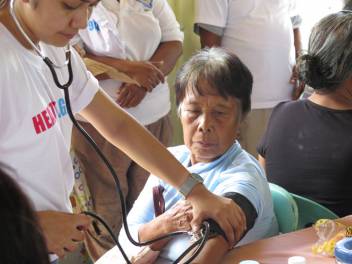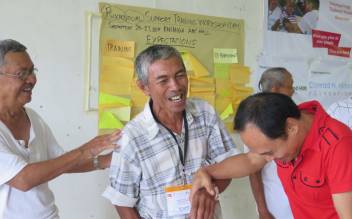 We knew a few days ahead of time that the typhoon was coming. The government was aware and warned the population.
We knew a few days ahead of time that the typhoon was coming. The government was aware and warned the population.
We, as the Coalition of Services for the Elderly (COSE), called our staff and told them to stay alert. In turn, they contacted the older people we work with in communities to let them know. At that time, the COSE emergencies team consisted of just a couple of people.
When the typhoon struck, I was with them in Manila planning our response. Within hours, we realised how bad it was. The next day we travelled to the worst hit areas, but we couldn’t reach even Tacloban because of the destruction; this is why our first distribution was in Ormoc.
I have never seen such destruction
In 22 years in the Philippines, I have never seen such destruction. The first thing I thought is that no one could have survived. It seemed like a miracle to me that anyone did. When I spoke to older people who had survived, they described the sound of the wind and the crash of water; it sounded like the end of the world.
We had to make very fast decisions, including finding out how much money we had so we could start distributing food straight away. Although we only had a small team on the ground, volunteers immediately started joining us to help with distributions and some lent us vehicles.
When I finally reached the typhoon-affected areas, there were families standing on the side the road, just staring. They didn’t know what to do. They had lost everything.
It’s amazing to see people smiling again
I’m very proud of the HelpAge and COSE joint response as we were one of the first NGOs to start responding and distributing food. I’ve just been visiting communities we’re supporting and it’s amazing to see people smile again after everything.
 Houses in Ormoc are being rebuilt and in some places you wouldn’t know the typhoon had happened. Although not everything has been rebuilt and there are still remnants of destruction.
Houses in Ormoc are being rebuilt and in some places you wouldn’t know the typhoon had happened. Although not everything has been rebuilt and there are still remnants of destruction.
For the future, it is crucial that older people are involved in every stage of planning their own recovery. That’s what we’re focusing on. We also want to improve older people’s social connectedness in emergency situations and ensure they participate fully in DRR work in their communities. They have a lot of knowledge to share.
We’re currently consulting older people individually and as groups to build age-friendly livelihoods. By the end of the year we hope to reach another 500 older people to have source of income. When it comes to shelter, we hope to have built 120 more houses in Ormoc for those older people who have no one to lean on before Christmas.
Older people now realise they contribute a lot in emergencies
We’re also doing advocacy work to raise awareness of older people’s issues. We want to try and set up help desks for older people in 11 municipalities, as they exist for women and children.
We’re working on extending health services for older people too. It’s a very unique programme, where we will have mobile medical clinics on motorbikes that carry medicines and nurses to extremely remote areas. The nurses do medical check-ups and report back to local health centres. This is happening in two municipalities to start with.
Earlier this year, I spoke to a lot of older people who had been part of our work. They said they were so happy that we were there to listen to them. They told us what they can do in emergencies. They felt that, because of our work, older people were not a burden in emergencies and they realised they had a lot to contribute.
They felt lucky to have organisations like COSE and HelpAge paying attention to them and making older people a priority. I have so many stories of how happy older people were that we came to help them.
I’m very optimistic about the future, I’m a positive person, there are challenges, but we can’t look back. We need to finish the job we’ve started.
The lessons I learnt from the typhoon are that people can do anything if they are motivated and are actively involved in their recovery.
Find out more about our work in the Philippines after Typhoon Haiyan.
